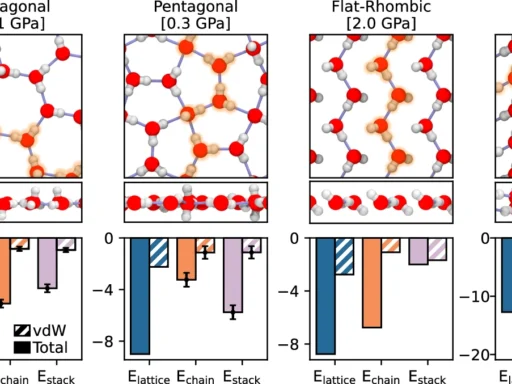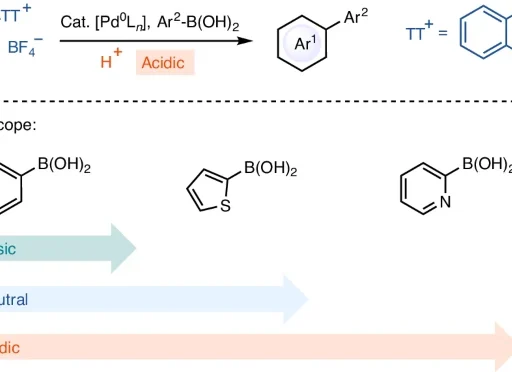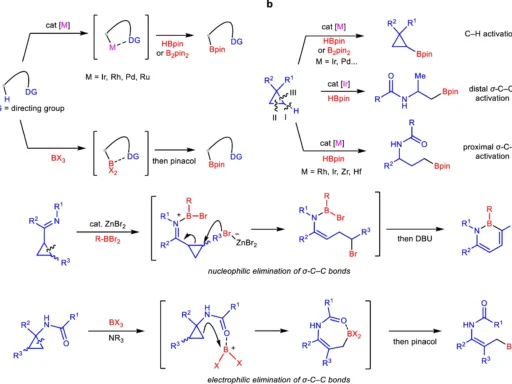Table of Contents
Overview:
Trace elements, although present in small amounts in minerals, are crucial for revealing important geological mysteries. Identifying and measuring trace elements is essential for interpreting both ancient rock formations and contemporary geological phenomena. However, how can one access these elusive particles without modifying the minerals? Geologists widely use nuclear magnetic resonance (NMR) spectroscopy, a highly effective technique, to detect trace elements in anhydrous minerals. The micro-scale quantitative NMR technology significantly transforms geologists’ approaches to this endeavor, offering intricate insights with exceptional accuracy.
Anhydrous minerals are those that do not contain water molecules in their chemical structure:
Anhydrous minerals are minerals that do not include water in their crystal structure. Anhydrous minerals lack any H2O molecules, unlike hydrated minerals, which include water molecules. Numerous geological environments frequently host these minerals, which include notable specimens such as quartz, olivine, and feldspar. Although these minerals may appear to be lacking moisture, they can contain small amounts of trace elements that have a substantial impact on their physical and chemical characteristics. Understanding the dispersion and density of these minute elements can provide insights into several aspects, ranging from the mineral’s history to the environmental circumstances in which it originated. Schematic representation of the quantification method using NMR spectroscopy.
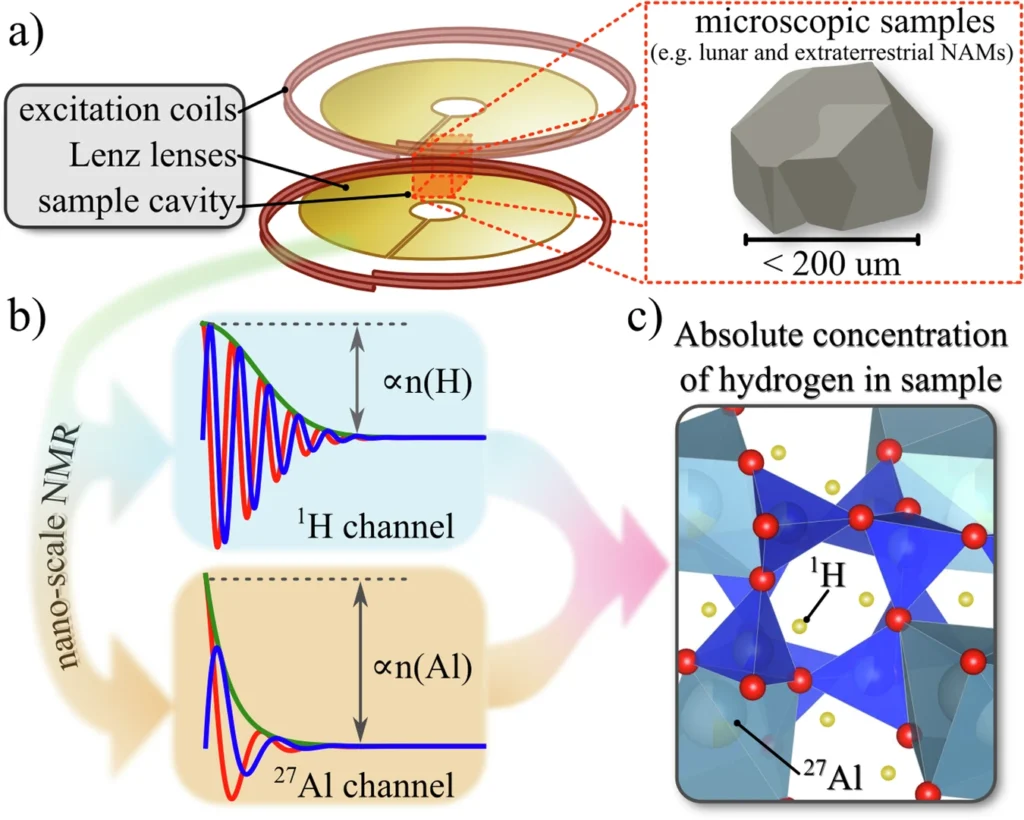
Comprehending Trace Elements:
What exactly are trace elements? In essence, these are constituents that exist in extremely small amounts—usually less than 1% by mass—in minerals. Although present in minute quantities, trace elements play a significant role in geological investigations. They have the potential to exert an impact on the color, hardness, and stability of minerals and are essential in various processes such as mineral production, rock metamorphism, and even the development of the Earth’s crust. Geologists see the ability to precisely identify and quantify these minute elements as equivalent to having a magnifying glass for studying the Earth’s geological processes.
An Overview of Nuclear Magnetic Resonance (NMR) Spectroscopy:
Nuclear magnetic resonance (NMR) spectroscopy, despite its somewhat fantastical nature, is a firmly established analytical technique employed in diverse scientific disciplines. NMR spectroscopy utilizes the magnetic characteristics of certain atomic nuclei. When subjected to a magnetic field and irradiated with radio waves of a particular frequency, these nuclei vibrate in resonance, generating detectable and analyzable signals. This method enables scientists to investigate the specimen’s molecular composition, movement, and surroundings, which is very valuable in mineralogy for identifying minute components. Benchmarking of hydrogen concentrations n(1H) obtained from μQ-NMR.
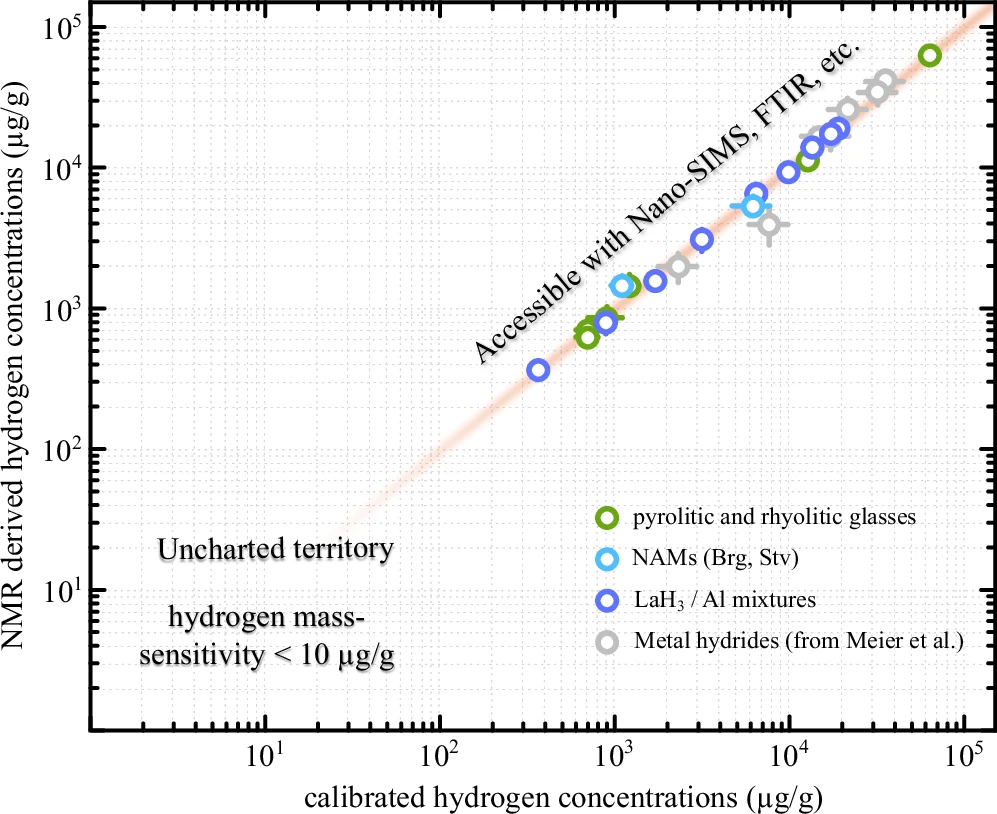
Quantitative Nuclear magnetic resonance (NMR) Spectroscopy at a Micro-Scale:
Although classical Nuclear magnetic resonance (NMR) spectroscopy has been in existence for many years, the micro-scale quantitative form is a more recent advancement. This method entails the examination of minuscule samples, often consisting of only a few micrograms, with the use of a specialized Nuclear magnetic resonance (NMR) apparatus. The distinguishing feature of micro-scale quantitative Nuclear magnetic resonance (NMR) is its ability to provide accurate quantitative information about trace element concentrations in these minuscule samples. Mineral investigations often restrict the sample size and find trace elements in extremely low quantities, making this particularly crucial.
Quantitative NMR for Trace Element Detection at Micro-Scale:
How does micro-scale quantitative NMR identify trace elements in anhydrous minerals? The procedure commences by positioning the mineral sample within a powerful magnetic field. Exposing the sample to radiofrequency pulses causes the nuclei of specific trace elements to vibrate at distinct frequencies. We identify the resonances and convert them into spectra, which we can examine to determine the presence and quantity of specific trace elements. The NMR equipment’s high sensitivity, which enables it to detect even the most subtle signals emitted by the trace elements present in the mineral, is the critical factor. 27Al-NMR and 1H-NMR time-domain data were acquired from three anorthites from meteorite ABL 001, Arguin 002, and ON 001 under ambient conditions.
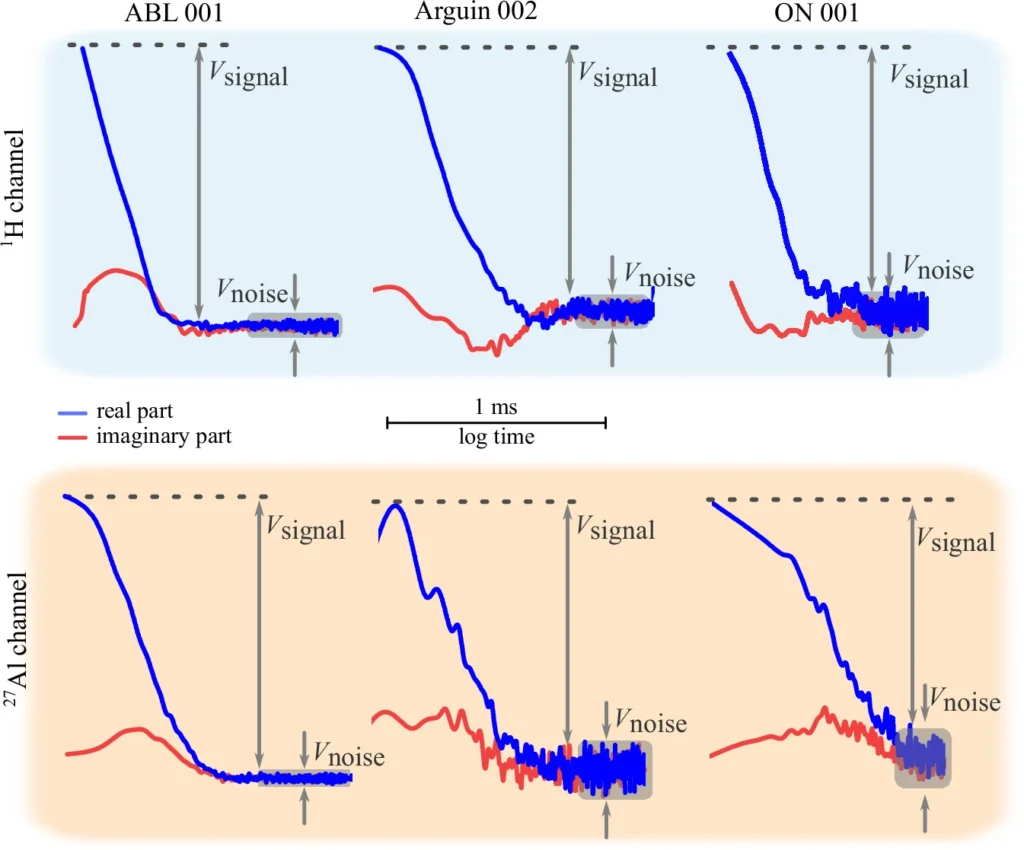
The process involves preparing samples for micro-scale Nuclear Magnetic Resonance (NMR) spectroscopy:
Sample preparation is an important stage in identifying trace elements using micro-scale NMR. The quality of sample preparation greatly influences the precision of the outcomes. This process entails pulverizing the mineral into a fine powder and ensuring that the sample is uniformly mixed. Minor discrepancies in the material can lead to significant inaccuracies in the NMR analysis. The small size of the examined samples makes any contamination or inappropriate handling liable to lead to inaccurate results. Therefore, careful preparation is very necessary for this process.
The focus is on quantitative analysis in nuclear magnetic resonance (NMR) spectroscopy:
NMR spectroscopy serves the purpose of not only detecting the existence of minute elements but also accurately measuring their quantities. Quantitative nuclear magnetic resonance (NMR) involves measuring the intensity of NMR signals, which directly corresponds to the concentration of trace elements in the sample. Scientists can properly quantify the content of each trace element by comparing the signal intensities to those of established standards. Calibration and standardization are essential in this context to guarantee the accuracy and reproducibility of the measurements. Representative single-grain multi-nuclear NMR spectra of meteoritic anorthosite Oued Namous 001.

The Benefits of Using NMR for Trace Element Detection:
What are the advantages of choosing NMR over other approaches for detecting trace elements? Firstly, the non-invasive nature of NMR spectroscopy ensures the material remains undamaged and ready for subsequent investigation. Additionally, it provides a high level of sensitivity and specificity, enabling the detection and quantification of trace components that may go unnoticed by alternative methods. In addition, NMR spectroscopy provides comprehensive data on the chemical surroundings of trace elements, providing a valuable understanding of their integration into the mineral’s structure. When compared to techniques such as X-ray fluorescence (XRF) or mass spectrometry, NMR stands out due to its capacity to study intricate combinations and offer detailed structural information.
Issues and Constraints of Micro-Scale NMR:
Although micro-scale NMR is a highly effective instrument, it is not devoid of difficulties. Micro-scale analysis necessitates highly specialized and costly equipment, hence limiting accessibility for some facilities. Moreover, the procedure necessitates a considerable level of proficiency to decipher the intricate data it produces. The minerals under study have certain limitations. Certain minerals may not generate sufficiently strong NMR signals, or the trace elements of relevance may lack appropriate NMR-active isotopes. Small sample sizes utilized in micro-scale NMR might occasionally result in challenges with sample representativeness, particularly when dealing with heterogeneous materials.
Utilization of Trace Element Detection in Geology:
Trace element detection in anhydrous minerals has many applications in geology. For instance, it assists scientists in understanding the conditions that led to the creation of minerals, providing insights into the temperature, pressure, and chemical conditions of previous geological environments. Petrology utilizes trace element analysis to elucidate the genesis and progression of magma, hence providing insights into volcanic phenomena and the genesis of igneous rocks. Geochemists utilize trace element data to investigate phenomena such as mineral weathering, erosion, and the movement of elements inside the Earth’s crust.
Advancements in Nuclear Magnetic Resonance (NMR) Spectroscopy in Recent Times:
The field of Nuclear magnetic resonance (NMR) spectroscopy is constantly evolving, with emerging advancements enhancing the technique’s potency and versatility. Recent advancements include the creation of magnets with greater magnetic fields, which improve NMR experiments’ sensitivity and accuracy. There is an increasing interest in integrating NMR with other analytical techniques, such as mass spectrometry or X-ray diffraction, to offer a more thorough study of mineral samples.
In the future, we anticipate witnessing additional advancements in micro-scale NMR technology, which will enhance its accessibility and broaden its scope of applications in mineralogy and other fields. Maximum water contents of anorthites (this study) and other NAMs from ungrouped achondrite meteorites23, angrites57, the Moon33,56,58,68, and the Earth11,69.
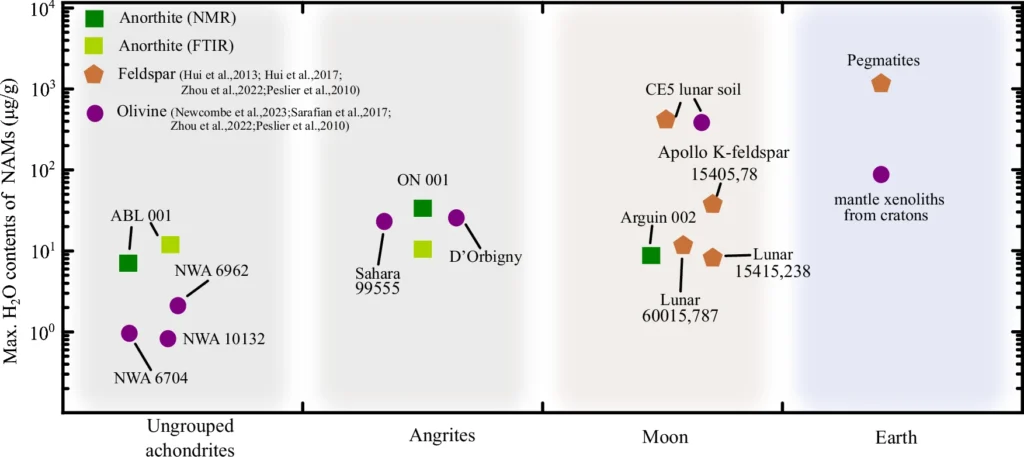
Anorthites of ABL 001 and ON 001 were simultaneously analyzed by FTIR, see Supplementary Figs. 6, 7. Three ungrouped achondrite olivines are from three individual parent bodies. Two lunar feldspars (K-feldspar and anorthites) from ferroan anorthite and Mg-suite troctolite were analyzed by Mills et al. 2017 and Hui et al. 201733,58and the feldspar and olivine from CE5 lunar soil were reported by Zhou et al. 202268. Source data are provided as a Source Data file.
Comparative Analysis: Nuclear Magnetic Resonance (NMR) versus Other Techniques:
When it comes to detecting trace elements, NMR spectroscopy is not the only method available. Commonly employed methods include X-ray fluorescence (XRF), inductively coupled plasma mass spectrometry (ICP-MS), and electron microprobe analysis. Nevertheless, every approach possesses its advantages and disadvantages. For instance, whereas XRF is highly effective at rapidly and non-destructively identifying a broad spectrum of elements, it does not offer the same level of precision regarding the chemical surroundings as NMR.
However, ICP-MS has exceptional sensitivity and can detect trace elements at levels as low as parts per billion. Nevertheless, it is a destructive method that necessitates the dissolution of the sample in acid. On the other hand, NMR’s non-destructive characteristics and capacity to offer intricate structural data make it exceptionally beneficial, particularly in research where maintaining the sample’s integrity is crucial.
Case studies: Practical applications in real-world scenarios
Let’s examine several case studies that demonstrate the practical application of micro-scale quantitative NMR in addressing real-world geological issues. A study utilized NMR to identify minute quantities of lithium in dehydrated minerals found in a pegmatite deposit, offering valuable information about the formation of minerals with high lithium content. Researchers used NMR to look at how rare earth elements were distributed in a group of igneous rocks. This helped them learn more about the magmatic processes that concentrate these valuable elements. These examples demonstrate the efficacy of Nuclear magnetic resonance (NMR) in revealing minerals’ hidden intricacies and providing fresh insights into geological phenomena.
In conclusion:
Micro-scale quantitative Nuclear magnetic resonance (NMR) spectroscopy is an advanced technique that is revolutionizing the identification and examination of minute quantities of elements in minerals without water. This approach’s non-destructive nature, coupled with its great sensitivity and capacity to provide precise chemical data, makes it an indispensable method in contemporary mineralogy. Despite the presence of hurdles and restrictions, the benefits of NMR are evident, especially in its capacity to provide unique insights that are not achievable through other methods. We expect the continuous advancement of technology to increase the significance of NMR in geology, providing increasingly precise insights into the concealed processes of the Earth.
Frequently Asked Questions:
1). What distinguishes NMR spectroscopy as a method for detecting trace elements?
NMR spectroscopy is a non-invasive technique that offers comprehensive insights into the chemical surroundings of trace elements, shedding light on their integration into the structure of minerals.
2). How precise is micro-scale quantitative NMR in identifying trace elements?
Using appropriate calibration and sample preparation techniques enhances the precision of micro-scale quantitative NMR. This technique enables the accurate measurement of minute amounts of trace elements in extremely small samples.
3). Is NMR spectroscopy applicable to all mineral types?
Although NMR is a versatile technique, it may not apply to all minerals. Certain minerals may not exhibit sufficiently robust NMR signals, or the desired trace elements may lack appropriate NMR-active isotopes.
4). What are the limitations of using NMR to analyze trace elements?
The primary constraints include the desire for expensive and specialized equipment, the need for proficient data interpretation, and difficulties in assessing certain mineral varieties and small sample quantities.
5). What’s the outlook for NMR spectroscopy in geology?
The future of NMR spectroscopy in geology is promising, as continuous technological developments enhance its sensitivity, resolution, and scope of applications. We anticipate mineralogical research to play a progressively significant role in it.
For more chemistry blogs, visit chemistry Master



